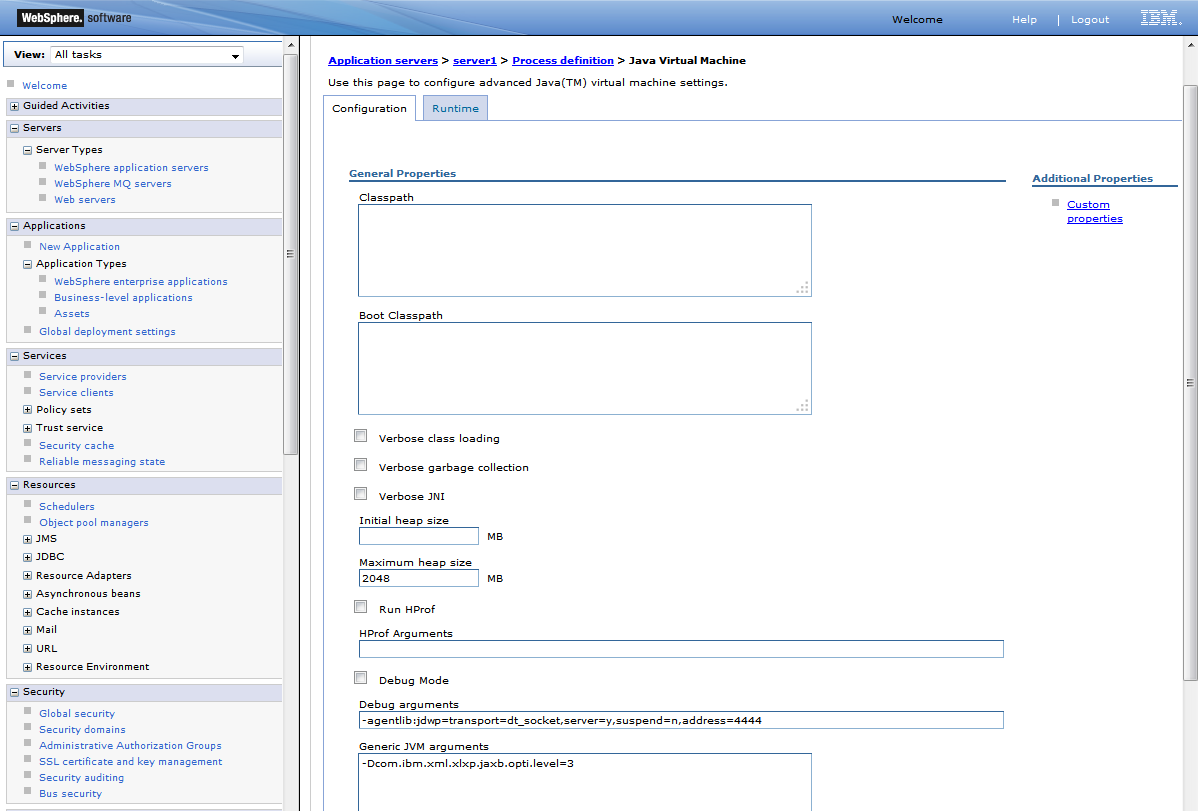IBM WebSphere
| Installation of IBM Websphere |
| Installation of CloverETL Server |
| Configuration of CloverETL Server on IBM WebSphere |
![[Important]](figures/important.png) | Important |
|---|---|
See Application Server in system requirements for currently supported IBM WebSphere versions and required Java versions. In order to ensure reliable function of CloverETL Server always use the latest version of IBM Java SDK. At least SDK 7.0 SR6 (package IBM WebSphere SDK Java Technology Edition V7.0.6.1) is recommended. Using older SDKs may lead to deadlocks during execution of specific ETL graphs. If you encounter any problems during the installation, the Possible Issues during Installation section may provide a solution. |
Installation of IBM Websphere
Create a My IBM account on https://www.ibm.com
Go to IBM Marketplace and download IBM Installation Manager.
Follow the instructions to download IBM Websphere.
CloverETL Server is developed and tested with the IBM WebSphere 7 and 8.5 container. Running the Server with other versions may result in unpredictable behavior.
Create a profile.
- Unix-like systems:
Run the [IBM_home]/WebSphere/AppServer/bin/ProfileManagement/pmt.sh. - Windows system:
Run the [IBM_home]\WebSphere\AppServer\bin\ProfileManagement\pmt.bat.
![[Important]](figures/important.png)
Important Make sure the profile name does not contain the keyword "clover", otherwise the CloverETL server won't start properly. - Unix-like systems:
Check whether the server is operational.
You will be prompted to run a first-time server management tool that will check whether the installation was successful and the server can be started.
Go to http://localhost:9060/ibm/console/ where you should be able to see the WebSphere login page.
Installation of CloverETL Server
Check if you meet the prerequisites:
IBM Java SDK is installed (see Java Virtual Machine for the required Java version).
JAVA_HOME or JRE_HOME environmental variable is set (see Setting up JAVA_HOME).
A supported version of IBM WebSphere is installed.
It is strongly recommended to adjust the default limits for Memory allocation (see the Memory Settings section).
You can set the limits in IBM WebSphere's Integrated Solutions Console (default URL: http://localhost:9060/ibm/console/).
Go to → → → → → →
Change the value in the Maximum heap size field to 2048 MB. The default value (256 MB) is insufficient for ETL transformations.

Figure 3.5. Adjusting Maximum heap size limit
Add the following parameters into the Generic JVM arguments field to set the perm space limit and direct memory limit:
-XX:MaxPermSize=512M-XX:MaxDirectMemorySize=512MJava runtime settings:
Go to → → → → and select version 1.7 as the default SDK.
Save the changes to configuration and restart the server so that they take effect.
Go to the download section of your CloverETL account and download the
clover.war(web archive) file containing CloverETL Server for WebSphere.Deploy the
clover.warfile.Go to Integrated Solutions Console (default URL: http://localhost:9060/ibm/console/).
Go to → → , select the CloverETL Server WAR archive and deploy it to the application server, but do not start it yet.
Configure application class loading.
Go to → → → and under Class loader order select Classes loaded with local class loader first (parent last).
Save the changes to the server configuration and start the clover_war application.
Check whether the server is running.
Provided you set
clover.waras the application running with "clover" context path, use the following URL (notice the port number has changed):
![[Note]](figures/note.png) | Note |
|---|---|
Please note that some CloverETL features using third party libraries do not work properly on IBM WebSphere.
|
Configuration of CloverETL Server on IBM WebSphere
![[Tip]](figures/tip.png) | Tip |
|---|---|
| Default installation (without any configuration) is only recommended for evaluation purposes. For production use, at least a dedicated database and SMTP server configuration is recommended. |
For detailed configuration of CloverETL Server, use a properties file. Here you can configure various properties, including the connection to the database, username and password, path to the license file, private properties, number of active threads, clusters and much more (see Chapter 9, List of Properties and Chapter 30, Cluster Configuration). The file can be placed either on a default, or specified location.
Content of such a file (example with MySQL database):
jdbc.driverClassName=com.mysql.jdbc.Driver jdbc.url=jdbc:mysql://127.0.0.1:3306/clover?useUnicode=true&characterEncoding=utf8 jdbc.username=yourUsername jdbc.password=yourPassword jdbc.dialect=org.hibernate.dialect.MySQLDialect
Properties File in Specified Location
The properties file is loaded from a location which is specified by the environment/system property
clover_config_file or clover.config.file.
Create the
cloverServer.propertiesfile in a directory readable by IBM WebSphere. (If you need an example of connection to any of supported databases, see Chapter 8, Examples of DB Connection Configuration.)Set system property (or environment variable)
clover_config_filepointing to the properties file.Go to Integrated Solutions Console (default URL:http://localhost:9060/ibm/console/).
Go to → → → → → → .
Create system property named
clover_config_filewhose value is a full path to the properties file (e.g.cloverServer.properties) on your file system.
Restart IBM WebSphere for changes to take effect.
![[Note]](figures/note.png) | Note |
|---|---|
|